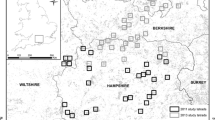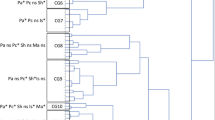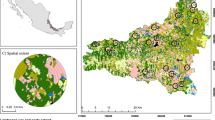Abstract
Context
Landscape heterogeneity (the composition and configuration of matrix habitats) plays a major role in shaping species communities in wooded-agricultural landscapes. However, few studies consider the influence of different types of semi-natural and linear habitats in the matrix, despite their known ecological value for biodiversity.
Objective
To investigate the importance of the composition and configuration of matrix habitats for woodland carabid communities and identify whether specific landscape features can help to maintain long-term populations in wooded-agricultural environments.
Methods
Carabids were sampled from woodlands in 36 tetrads of 4 km2 across southern Britain. Landscape heterogeneity including an innovative representation of linear habitats was quantified for each tetrad. Carabid community response was analysed using ordination methods combined with variation partitioning and additional response trait analyses.
Results
Woodland carabid community response was trait-specific and better explained by simultaneously considering the composition and configuration of matrix habitats. Semi-natural and linear features provided significant refuge habitat and functional connectivity. Mature hedgerows were essential for slow-dispersing carabids in fragmented landscapes. Species commonly associated with heathland were correlated with inland water and woodland patches despite widespread heathland conversion to agricultural land, suggesting that species may persist for some decades when elements representative of the original habitat are retained following landscape modification.
Conclusions
Semi-natural and linear habitats have high biodiversity value. Landowners should identify features that can provide additional resources or functional connectivity for species relative to other habitat types in the landscape matrix. Agri-environment options should consider landscape heterogeneity to identify the most efficacious changes for biodiversity.




Similar content being viewed by others
References
Aviron S, Burel F, Baudry J, Schermann N (2005) Carabid assemblages in agricultural landscapes: impacts of habitat features, landscape context at different spatial scales and farming intensity. Agric Ecosyst Environ 108:205–217
Bakker JP, Berendse F (2001) Constraints in the restoration of ecological diversity in grassland and heathland communities. Trends Ecol Evol 14:63–68
Barbaro L, van Halder I (2009) Linking bird, carabid beetle and butterfly life history traits to habitat fragmentation in mosaic landscapes. Ecography 32:321–333
Barbaro L, Rossi J-P, Vetillard F, Nezan J, Jactel H (2007) The spatial distribution of birds and carabid beetles in pine plantation forests: the role of landscape composition and structure. J Biogeogr 34:652–664
Bellamy P, Hinsley SA, Newton I (1996) Factors influencing bird species numbers in small woods in south-east England. J Appl Ecol 33:249–262
Bennett AF, Radford JQ, Haslem A (2006) Properties of land mosaics: implications for nature conservation in agricultural environments. Biol Conserv 133:250–264
Billeter R, Liira J, Bailey D, Bugter R, Arens P, Augenstein I, Aviron S, Baudry J, Bukacek R, Burel F, Cerny M, de Blust G, de Cock R, Diekötter T, Dietz H, Dirksen J, Dormann C, Durka W, Frenzel M, Hamersky R, Hendrickx F, Herzog F, Klotz S, Koolstra B, Lausch A, le Couer D, Maelfait JP, Opdam P, Roubalova M, Schermann A, Schermann N, Schmidt T, Schweiger O, Smulders MJM, Speelmans M, Simova P, Verboom J, van Wingerden WKRE, Zobel M, Edwards PJ (2008) Indicators for biodiversity in agricultural landscapes: a pan-European study. J Appl Ecol 45:141–150
Borcard D, Legendre P (2002) All-scale spatial analysis of ecological data by means of principal coordinates of neighbour matrices. Ecol Model 153:51–68
Brouwers N, Newton AC (2009) Movement rates of woodland invertebrates: a systematic review of empirical evidence. Insect Conserv Divers 2:10–22
Clark AN (2011) Data from: The land utilisation survey of Britain, 1933–1949 (unpublished). Coverage: Great Britain. Environment Agency and obtained under Special Non-Commercial licence. Available from http://data.gov.uk/dataset/digital-land-utilisation-survey-1933-1949-afa213
Cleveland WS (1993) Visualizing data. Hobart Press, New Jersey
Cushman SA, McGarigal K (2003) Landscape-level patterns of avian diversity in the Oregon Coast Range. Ecol Monogr 73:259–281
Daily GC, Ehrlich P, Sánchez-Azofeifa A (2001) Countryside biogeography: use of human-dominated habitats by the avifauna of southern Costa Rica. Ecol Appl 11:1–13
Davey CM, Vickery JA, Boatman ND, Chamberlain DE, Parry HR, Siriwardena GM (2010) Assessing the impact of Entry Level Stewardship on lowland farmland birds in England. Ibis 152:459–474
Devictor V, Jiguet F (2007) Community richness and stability in agricultural landscapes: the importance of surrounding habitats. Agric Ecosyst Environ 120:179–184
Digweed SC, Currie CR, Carcamo HA, Spence JR (1995) Digging out the “digging-in-effect” of pitfall traps: influences of depletion and disturbance on catches of ground beetles (Coleoptera: Carabidae). Pedobiologia 39:561–576
Dray S, Choler P, Dole S, Peres-Neto PR, Thuiller W, Pavoine S, ter Braak CJF (2014) Combining the fourth-corner and the RLQ methods for assessing trait responses to environmental variation. Ecology 95:14–21
Duflot R, Georges R, Ernoult A, Aviron S, Burel F (2014) Landscape heterogeneity as an ecological filter of species traits. Acta Oecol 56:19–26
Eyre MD, Luff ML (2004) Ground beetle species (Coleoptera, Carabidae) associations with land cover variables in northern England and southern Scotland. Ecography 27:417–426
Fahrig L (2003) Effects of habitat fragmentation on biodiversity. Annu Rev Ecol Evol Syst 34:487–515
Fahrig L, Baudry J, Brotons L, Burel FG, Crist TO, Fuller RJ, Sirami C, Siriwardena G, Martin J-L (2011) Functional landscape heterogeneity and animal biodiversity in agricultural landscapes. Ecol Lett 14:101–112
Firbank LG, Petit S, Smart S, Blain A, Fuller RJ (2007) Assessing the impacts of agricultural intensification on biodiversity; a British perspective. Philos Trans R Soc Lond B Biol Sci 363:777–787
Forsythe TG (2000) Ground beetles. Naturalists’ Handbook 8. Richmond Publishing, Newbury
Fuller RM, Smith GM, Sanderson JM, Hill RA, Thomson AG, Cox R (2002) Data from: Land Cover Map 2000. Centre for Ecology and Hydrology and Natural Environment Research Council. Coverage: Great Britain. Available from http://www.ceh.ac.uk/landcovermap2000.html
Gardiner T (2007) Orthoptera of crossfield and headland footpaths in arable farmland. J Orthop Res 16:127–133
Gibb H, Hjalten J, Ball J, Pettersson RB, Landin J, Alvini O, Danell K (2006) Wing loading and habitat selection in forest beetles: Are red-listed species poorer dispersers or more habitat-specific than common congenerics? Biol Conserv 132:150–160
Gimingham CH (1972) Ecology of heathlands. Chapman Hall, London
Green RE, Osborne PE, Sears EJ (1994) The distribution of passerine birds during the breeding season in relation to characteristics of the hedgerow and adjacent farmland. J Appl Ecol 31:677–692
Haslem A, Bennett AF (2008) Birds in agricultural mosaics: the influence of landscape pattern and countryside heterogeneity. Ecol Appl 18:185–196
Heikkinen RK, Luoto M, Virkkala R, Rainio K (2004) Effects of habitat cover, landscape structure and spatial variables on the abundance of birds in an agricultural forest mosaic. J Appl Ecol 41:824–835
Hendrickx F, Maelfait J, Van Wingerden W, Schweiger O, Speelmans M, Aviron S, Augenstein I, Billeter R, Bailey D, Bukacek R, Burel F, Diekotter T, Dirksen J, Herzog F, Liira J, Roubalova M, Vandomme V, Bugter R (2007) How landscape structure, land-use intensity and habitat diversity affect components of total arthropod diversity in agricultural landscapes. J Appl Ecol 44:340–351
Hinsley SA, Bellamy PE (2000) The influence of hedge structure, management and landscape context on the value of hedgerows to birds: a review. J Environ Manag 80:33–49
Hooftman DAP, Bullock JM (2012) Mapping to inform conservation: a case study of changes in semi-natural habitats and their connectivity over 70 years. Biol Conserv 145:30–38
Jopp F, Reuter H (2005) Dispersal of carabid beetles—emergence of distribution patterns. Ecol Model 186:389–405
Judas M, Dornieden K, Strothmann U (2002) Distribution patterns of carabid beetle species at the landscape-level. J Biogeogr 29:491–508
Kallimanis AS, Mazaris AD, Tzanopoulos J, Halley JM, Pantis JD, Sgardelis SP, McGill B (2008) How does habitat diversity affect the species-area relationship? Glob Ecol Biogeogr 17:535–538
Kang B, Lee J-H, Park J-K (2012) Carabid beetle species as a biological indicator for different habitat types of agricultural landscapes in Korea. J Ecol Field Biol 35:35–39
Koivula M (2005) Effects of forest roads on spatial distribution of boreal carabid species (Coleoptera; Carabidae). Coleopt Bull 59:465–487
Korhonen JJ, Soininen J, Hillebrand H (2010) A quantitative analysis of temporal turnover in aquatic species assemblages across ecosystems. Ecology 91:508–517
Kotze JD, O’Hara RB (2003) Species decline: but why? Explanations of carabid beetle (Coleoptera, Carabidae) declines in Europe. Oecologia 135:138–148
Larcher F, Baudry J (2013) Landscape grammar: a method to analyse and design hedgerows and networks. Agrofor Syst 87:181–192
Lavorel S, Mcintyre S, Landsberg J, Forbes TDA (1997) Plant functional classifications: from general groups to specific groups based on response to disturbance. Trends Ecol Evol 12:474–478
Lawton H, Brotherton PNM, Brown VK, Elphick C, Fitter AH, Forshaw J, Haddow RW, Hilborne S, Leafe RN, Mace GM, Southgate MP, Sutherland WJ, Tew TE, Varley J, Wynne GR (2010) Making space for nature: a review of England’s wildlife sites and ecological network. Report to Defra. Available from http://archive.defra.gov.uk/environment/biodiversity/documents/201009space-for-nature.pdf. Accessed 12 June 2013
Legendre P, Legendre L (1998) Numerical ecology, 2nd edn. Elsevier Science, Amsterdam
Lindborg R, Eriksson O (2004) Historical landscape connectivity affects present plant species diversity. Ecology 85:1840–1845
Luff ML (2007) The Carabidae (ground beetles) of Britain and Ireland. FSC Publications, Shrewsbury
Mason WL (2007) Changes in the management of British forests between 1945 and 2000 and possible future trends. Ibis 149:41–52
Mayfield M, Daily G (2005) Countryside biogeography of neotropical herbaceous and shrubby plants. Ecol Appl 15:423–439
Mayfield M, Bonser SP, Morgan J, Aubin I, McNamara S, Vesk PA (2010) What does species richness tell us about functional trait diversity? Predictions and evidence for responses of species and functional trait diversity to land-use change. Global Ecol Biogeogr 19:423–431
McGarigal K, Ene E (2012) Fragstats 4.1: a spatial pattern analysis program for categorical maps. Computer software program produced by the authors at the University of Massachusetts, Amherst. Available from http://www.umass.edu/landeco/research/fragstats/fragstats.html
Öckinger E, Smith HG (2006) Landscape composition and habitat area affects butterfly species richness in semi-natural grasslands. Oecologia 149:526–534
Oliver T, Roy DB, Hill JK, Brereton T, Thomas CD (2010) Heterogeneous landscapes promote population stability. Ecol Lett 13:473–484
Ordnance Survey (2010) MasterMap Download. Edina Digimap. Data obtained under licence. Available from http://digimap.edina.ac.uk/mastermapdownloader/Downloader
Ordnance Survey (2012) OS Open Source. Coverage: Great Britain. Updated 2011, Ordnance Survey Open Data, GB. Available from http://www.ordnancesurvey.co.uk/oswebsite/products/
Petit S, Burel F (1998) Effects of landscape dynamics on the metapopulation of a ground beetle (Coleoptera, Carabidae) in a hedgerow network. Agric Ecosyst Environ 69:243–252
Piessens K, Hermy M (2006) Does the heathland flora in north-western Belgium show an extinction debt? Biol Conserv 132:382–394
Piqueray J, Bisteau E, Cristofoli S, Palm R, Poschlod P, Mahy G (2011) Plant species extinction debt in a temperate biodiversity hotspot: community, species and functional traits approaches. Biol Conserv 144:1619–1629
Purtauf T, Roschewitz I, Dauber J, Thies C, Tscharnkte T, Volkmar W (2005) Landscape context of organic and conventional farms: influences on carabid beetle diversity. Agric Ecosyst Environ 108:165–174
Radford JQ, Bennett AF (2007) The relative importance of landscape properties for woodland birds in agricultural environments. J Appl Ecol 44:737–747
Ribera I, Dec S, Downie I, Foster G (2001) Effect of land disturbance and stress on species traits of ground beetle assemblages. Ecology 84:1112–1129
Rodewald AD (2003) The importance of land uses within the landscape matrix. Wildl Soc Bull 31:586–592
Schweiger O, Maelfait JP, Van Wingerden W, Hendrickx F, Billeter R, Speelmans M, Augenstein I, Aukema B, Aviron S, Bailey D, Bukacek R, Burel F, Diekötter T, Dirksen J, Frenzel M, Herzog F, Liira J, Roubolava M, Bugter R (2005) Quantifying the impact of environmental factors on arthropod communities in agricultural landscapes across organizational levels and spatial scales. J Appl Ecol 42:1129–1139
Šmilauer P, Leps J (2014) Multivariate analysis of ecological data using Canoco 5, 2nd edn. Cambridge University Press, Cambridge
Taboada A, Kotze DJ, Salgado JM (2004) Carabid beetle occurrence at the edges of oak and beech forests in NW Spain. Eur J Entomol 101:555–563
Ter Braak CJF, Šmilauer P (2012) Canoco reference manual and user’s guide: software for ordination. Version 5.0. Microcomputer Power, Ithaca
Terra Metrics (2009) Google Maps UK. Available from https://www.google.co.uk/maps/. Accessed 11 June 2011
Thomas CG, Parkinson L, Griffiths GJK, Fernandez Garcia A, Marshall EJP (2001) Aggregation and temporal stability of carabid beetle distributions in field and hedgerow habitats. J Appl Ecol 38:100–116
Vanbergen AJ, Woodcock BA, Watt AD, Nimela J (2005) Effect of land-use heterogeneity on carabid communities at the landscape scale. Ecography 28:3–16
Ward DF, New TR, Yen AL (2001) Effects of pitfall trap spacing on the abundance, richness and composition of invertebrate catches. J Insect Conserv 5:47–53
Acknowledgments
We are grateful to the Game and Wildlife Conservation Trust for the funding provided, to landowners who granted us permission to access their land and to Chris Foster for help with fieldwork. Finally, thanks to Jonathan Bradley for his comments and corrections on the first draft of this manuscript.
Author information
Authors and Affiliations
Corresponding author
Electronic supplementary material
Below is the link to the electronic supplementary material.
Rights and permissions
About this article
Cite this article
Neumann, J.L., Griffiths, G.H., Hoodless, A. et al. The compositional and configurational heterogeneity of matrix habitats shape woodland carabid communities in wooded-agricultural landscapes. Landscape Ecol 31, 301–315 (2016). https://doi.org/10.1007/s10980-015-0244-y
Received:
Accepted:
Published:
Issue Date:
DOI: https://doi.org/10.1007/s10980-015-0244-y




